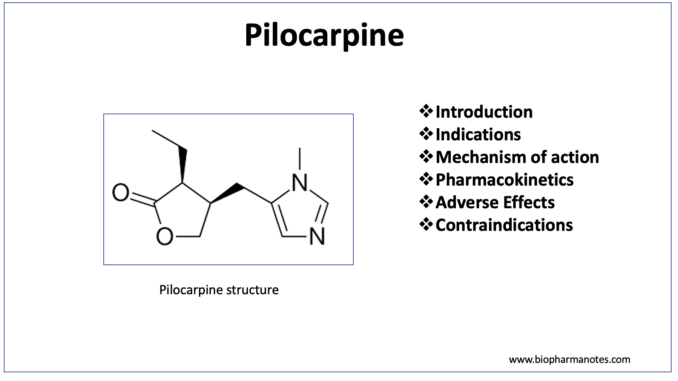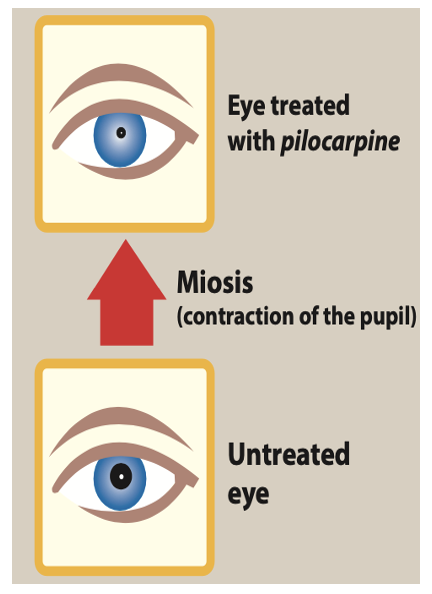
- Pilocarpine is alkaloid obtained from plants Pilocarpus microphyllus and Pilocarpus jaborandi. It possesses muscarinic cholinergic agonist properties.
- It mimics the action of acetylcholine. Acetylcholine (Ach) is an organic chemical that function in the body as neurotransmitter.
Indications
- It is used alone or in combination with 1 % physostigmine in acute congestive glaucoma to reduce intraocular pressure (IOP). It causes immediate reduction in IOP by increasing drainage of aqueous humor within few minutes.
- Used in treating radiating induced dry mouth (xerostomia).
- Used in treating symptoms of dry mouth in patient with Sjogren’s syndrome.
Mechanism of action
- It is cholinergic parasympathomimetic agent. It exerts partial and full agonistic effect on muscarinic M3 receptor. M3 muscarinic receptor is excitatory receptor mostly present in salivary glands, gastric glands and smooth muscle cell present in ciliary bodies and pupillary sphincter of eye.
- When M3 receptor is activated, it activates phospholipase C and leads to generation of second messenger inositol triphosphate and diacylglycerol. This results in upregulation of calcium causing smooth muscle contraction of pupillary sphincter and ciliary body. This mechanism of action makes it useful as miotic agent while treating glaucoma.
- The activation of M3 receptor also causes increase in secretion of salivary glands and hence is useful in treating xerostomia and Sjogren’s disease.

Figure- Action of Pilocarpine on iris and ciliary body of eye (Source- Lippincott’s illustrated Reviews Pharmacology, 6th edition)
Pharmacokinetics
- For ophthalmic use, it is applied topically and is available as ophthalmic eye drops. It is administered through oral for xerostomia and Sjogren’s syndrome. The systemic form is not available as the drug would be too toxic. It is also available as special drug delivery unit called pilocarpine ocusert which can deliver pilocarpine slowly for 7 days.
- After oral administration, it can stimulate salivary secretion within 15 minutes and the effect lasts for around 1-2 hours.
- In patients with xerostomia, the usual dosage is 5 mg three times per day initially. The dose is titrated depending on patient’s response. In patients with Sjogren’s syndrome, the typical dosage is 4 times per day. The maximum dose allowed in case of oral administration is 10 mg per dose and 30 mg per day.
Adverse effects
- Pilocarpine is nonselective muscarinic agonist. It can act on other muscarinic receptors also beside M3 receptor. As muscarinic receptors are present in almost all major systems of our body, pilocarpine can mediate autonomic actions and produce side effects.
- It can affect M3 receptor present in blood vessels leading to vasodilation and cause hypotension and flushing. It can also cause blurred vision, brow ache and night blindness. The adverse effects related to its parasympathomimetic actions are excessive salivation and diaphoresis (excessive sweating).
- The toxic effects of pilocarpine can be managed by using parenteral atropine. The dose of atropine used should be sufficient to cross blood brain barrier (BBB).
Contraindications
- It is contraindicated in disease of systems which may be affected by presence of muscarinic receptors. The disease may include peptic ulcer, COPD (chronic obstructive pulmonary disease), orthostatic hypotension, hyperthyroidism, coronary vascular disease and severe miosis.
- Contraindicated in patient with drug induced xerostomia.
- It is contraindicated in patients with history of myocardial infarction.
- Its use is not recommended in pregnancy.
References
- https://www.statpearls.com/ArticleLibrary/viewarticle/27218
- https://go.drugbank.com/drugs/DB01085
- https://www.medicinenet.com/pilocarpine/article.htm#what_are_the_side_effects_of_pilocarpine
- Wiseman LR et al. Oral Pilocarpine: A Review of its Pharmacological Properties and Clinical Potential in Xerostomia. Drugs. 1995; 49: 143–155.
- Pharmacology and Pharmacotherapeutics. 24th edition.
- Goodman and Gillman Manual of Pharmacology and Therapeutics.
- Lippincott Illustrated Reviews Pharmacology, 6th edition.